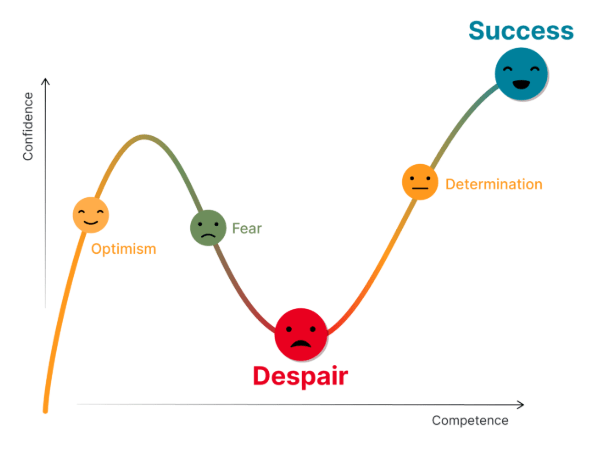Down & Out in the Valley of Despair: How to Manage Change and Succeed at New Software Adoption
Implementing a new project management system can be exciting. BUT.
When the time comes to actually onboard new PM software, the shine can wear off.
You might have heard the term Valley of Despair: This is a common phrase in software adoption that describes the point where enthusiasm fades and adoption challenges emerge. With clear roles and goals, you can push through change management struggles and start notching some quick wins.
The complete journey to succeed in onboarding new project management software often looks like this:

- Optimism: Early peak excitement sets in as teams anticipate better tools and new efficiencies.
- Fear: As the reality of change becomes clearer, team members may worry about changing their established process, learning something new, and maybe even losing mastery of their processes and job.
- Despair: Processes feel unfamiliar, onboarding may be lacking, adoption is frustrating, and confidence in both the new tool and one’s ability to use it dips. Without flexibility and support, people may feel disconnected from the purpose of the change.
- Determination: Time passes, the team gets used to new processes, and small wins start to build. Maybe this could be a good thing.
- Success: Teams make the new software work for them: They take ownership, and the new way of working becomes routine. And it really is faster and easier!
In the Valley of Despair, users face the everyday challenges of learning a new tool. Training may be lacking, new processes don’t fit how everyone actually works, and confidence drops.
Tasks take longer, workflows aren’t the same tried-and-true processes, and some team members resist using the system.
It’s a natural part of adoption. Software works differently in practice than it does in demos, and people need time and support to adjust.
Successfully moving through the Valley of Despair requires structure and clarity:

-
- Leadership support ensures everyone understands why the new system matters.
- Defined goals clarify what success looks like, so teams know what they are working toward.
- Regular, simple communication keeps everyone on the same page and addresses questions quickly.
- Checkpoints and small wins help maintain momentum and build confidence.
- Roles and responsibilities must also be clear. Who manages implementation? Who is responsible for answering questions and troubleshooting? Without defined ownership, adoption stalls.
Identify software “champions” within teams to help guide hesitant users and encourage consistent use.
The Valley of Despair isn’t a sign that the software is wrong—it’s a phase every team goes through when introducing new processes. Teams that plan for it and support their people can move past frustration to ownership.
When adoption succeeds, the organization gains more than just a new tool: workflows improve, visibility increases, and teams collaborate more effectively.
For construction leaders facing these adoption challenges, download our new practical roadmap through the Valley of Despair.


